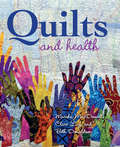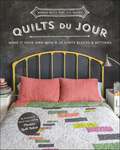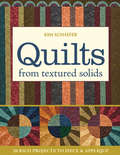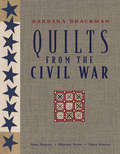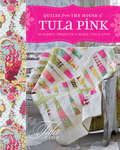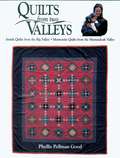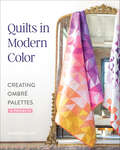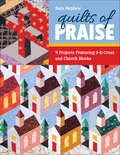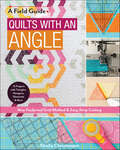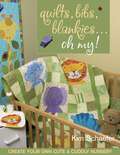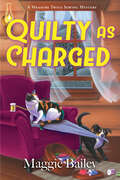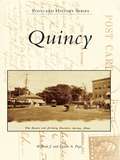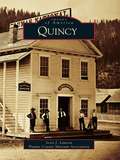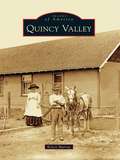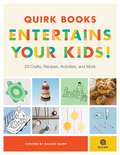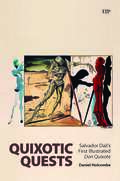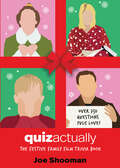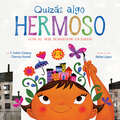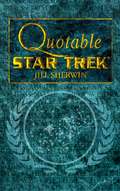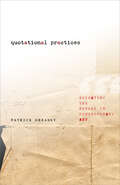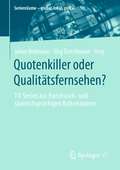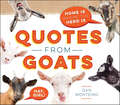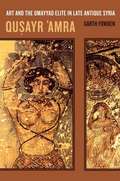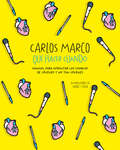- Table View
- List View
Quilts and Health
by Marsha MacDowell Clare Luz Beth DonaldsonName an illness, medical condition, or disease and you will find quiltmaking associated with it. From Alzheimer’s to Irritable Bowel Syndrome, Lou Gehrig's Disease to Crigler-Najjar Syndrome, and for nearly every form of cancer, millions of quilts have been made in support of personal well-being, health education, patient advocacy, memorialization of victims, and fundraising. In Quilts and Health, Marsha MacDowell, Clare Luz, and Beth Donaldson explore the long historical connection between textiles and health and its continued and ever growing importance in contemporary society. This lavishly illustrated book brings together hundreds of health-related quilts—with imagery from abstract patterns to depictions of fibromyalgia to an ovarian cancer diary—and the stories behind the art, as told by makers, recipients, healthcare professionals, and many others. This incredible book speaks to the healing power of quilts and quiltmaking and to the deep connections between art and health.
Quilts du Jour: Make It Your Own with à la Carte Blocks & Settings
by Marny Buck Jill Guffy18 perfect pairings from Modern Quilt Relish Whet your appetite for delicious designs from the creators of Modern Quilt Relish. Savor easy-to-sew patterns influenced by modern cuisine, such as the crispy wonton block and tempting turnovers quilt. Prepare one of 18 delectable projects, suitable for all skill levels. Or if you prefer, cook up something totally you when you choose a block, setting, and size from the appetizing menus. This value-packed pattern collection comes with innovative layouts that all quilters—modern, traditional, and those in between—will appreciate. • Mouthwatering menu of 18 quilts and pillow projects inspired by modern cuisine • Great value! Interchangeable menu of blocks, settings, and sizes to design your own quilt • Easy patchwork blocks—ideal for beginners • Innovative settings that Modern Quilt Relish fans have grown to love
Quilts from Textured Solids: 20 Rich Projects to Piece & Appliqué
by Kim SchaeferCreate modern lap quilts, wall quilts, and table runners with these 20 new projects by the bestselling author of Kim Schaefer’s Calendar Quilts.Go bold with modern tones!• Simple shapes and easy construction yield sophisticated quilts for every room in the house• Textured solid fabrics add depth and interest to every fresh design• Quilt designs are perfect for embellishing with buttons• Hone your color-matching skills by working with tone-on-tone and solid fabricsGive your quilts a more tactile touch with 20 new projects that feature rich, textured solids to create timeless designs. Use machine appliqué and traditional piecing techniques to stitch up lap quilts, wall quilts, and table runners in Kim’s popular style and color palette.
Quilts from Tilda's Studio (Tilda)
by Tone FinnangerThe beloved Scandinavian Tilda brand brings you quilts for all seasons—from springtime’s Scrapflower Quilt to winter’s Happy Snowman Quilt.World-renowned for her beautiful fabrics and charming designs, Tone Finnanger has established Tilda as a creative lifestyle that makers dream of. From her inspirational studio on an island in Norway’s Oslofjord, comes this divine collection of quilt patterns, all made with the latest Tilda fabric collections.Fourteen quilts, many with matching pillows, are shown with gorgeous photography, in-depth instructions, piecing diagrams and full-size templates. The designs feature a range of motifs including cats, angels, birdhouses, trees, teapots, fruit, flowers and more that quilters will simply adore. Cut, piece, baste, quilt and bind your way into Tilda’s world with this exquisite pattern book, and make quilts you’ll cherish forever.
Quilts from the Civil War: Nine Projects, Historic Notes, Diary Entries
by Barbara BrackmanDiscover the history of Civil War era quilting and learn how to create your own period-inspired quilt.Quilts and their makers are an integral part of the story about this incredible period of American history. Barbara Brackman offers a rarely discussed perspective from half of those who lived through it—the women of the North and the South. Included are complete instructions for nine projects, which are adapted from historical quilts and convey an authentic feel. Definitely modern quilt-making techniques will inspire both faithful reproductions and contemporary adaptations of Civil War era quilts. The book includes tips for using today&’s reproduction fabrics and suggestions for achieving a period look. Fascinating photos and excerpts from diaries and letters capture the patriotism and frustration of courageous women on both sides of the conflict.&“Excellent! The convergence of powerful and poignant scholarship with related quilt patterns is absolutely marvelous. An excellent resource for history buffs, feminist studies, as well as quilters.&”—Carolyn L. Mazloomi, Founder/Coordinator, The Women of Color Quilter&’s Network&“A fresh and entertaining look at the history of quilt making during the mid-19th century with a meticulous investigation of the textiles utilized. Barbara&’s use of primary sources, such as diaries, newspapers, and magazines from this era, enables us to better understand the conditions surrounding the women of this period.&”—Sheila Morris Greene, Curator of Costumes and Textiles, Tennessee State Museum
Quilts from the House of Tula Pink: 20 Fabric Projects to Make, Use and Love
by Tula PinkInspired fabrics and designs await you in Quilts From the House of Tula Pink! Welcome to the world of cutting-edge fabric designer Tula Pink, where clever quilts show off fanciful fabric, and your imagination can be let out to play. Featuring fabrics that you know and love, Tula offers 20 patterns with her signature flair for color, design and original style. Between 10 amazing quilts and 10 extra-cool companion projects, you'll be inspired to play with fabric, color and design in a way like never before! Step inside to find: • 10 large quilt patterns, perfect for the bedroom or snuggling on the couch. • 10 accessory sewing projects, like an embroidered lampshade and a fabric cuckoo clock, to make your everyday life extraordinary. • Tips from Tula on choosing and combining fabrics, selecting a quilting motif, and even sketching your own fabric and pattern designs. • Step-by-step illustrations (hand-drawn by Tula herself) and super-simple sewing techniques for successful quilt making. Come on in to Tula's house for the ultimate in sewing, style and fabric innovation!
Quilts from two Valleys: Amish Quilts From The Big Valley-Mennonite Quilts From The Shenandoah Valley
by Phyllis GoodTwo hidden valleys-one in Pennsylvania, the other in Virginia-held vibrant communities and quilting traditions during the closing years of the 19th century and the early decades of the 20th century. How do the quilts made by the Amish and Mennonites in these tucked-away places compare? Includes photographs of richly colorful quilts, and of the two communities from which they come. "Full of bright color and examples of phenomenal hand-quilting, this book is great for your personal library or for a gift for a friend." -Quilting Quarterly "The elegant designs of these quilts give insight into the simple and unique lifestyles of their makers. Phyllis includes biographical information about the two groups along with photos of them and their work." -Quilter's Newsletter Magazine
Quilts in Modern Color: Creating Ombré Palettes
by Amber ElliotBuild vibrant color palettes for stunning contemporary quilts Learn to craft stunning ombré color palettes and apply them to gorgeously designed modern quilts! This collection includes ten full-size quilts and four small quilt projects, each perfectly designed for a palette of beautiful gradient colors from modern quilt designer Amber Elliot. From timeless stars to hypnotic medallions, explore a range of styles for a variety of skill levels. Dive deep into a new understanding of color, following Amber’s guidelines and methodologies for creating a palette. And, after working through each inspiring project, apply your color-picking knowledge to elevate all of your quilts. In this collection, contemporary color choices meet breathtaking modern design! Explore a captivating collection of modern quilt patterns that appeal to a contemporary audience, curated and designed by Amber Elliot Includes ten full-size quilts and four small projects that teach you to build color gradients in a wide variety of ombre-friendly designs Includes a full section on understanding and picking color palettes, translating color to fabric choice, and choosing the right palette and gradient for each quilt in the collection
Quilts of Praise: 9 Projects Featuring 3D Cross & Church Blocks
by Sara NephewCreate devotional 3D quilt blocks showcasing crosses and churches! Crosses and churches graciously soar off the surface of Sara Nephew’s 3D block quilts. Perfect for special occasions year-round—weddings, christenings, memorials, and more — 3D block projects from Quilts of Praise make meaningful religious gifts, church decor, or cherished keepsakes. The book features nine quilt projects in various combinations of the basic blocks, offering a variety of finished pieces from bed-sized quilts to wall hangings to altar cloths and stoles. Sara guides readers step-by-step through each project, including working with value to develop attractive 3D illusions. A gallery of finished pieces inspires additional combinations and colorways. Religious-themed quilt projects are perfect for special occasions or as church decor Achieve stunning 3D effects! The blocks soar off of the surface of the quilt 9 quilt projects showcasing variations and combinations of the basic blocks
Quilts with an Angle: A Field Guide
by Sheila ChristensenTriangles, hexagons, diamonds, and more! Learn to measure, rotary cut, and machine piece 60° shapes with ease. Don’t be intimidated—triangle quilts are actually easy to put together when viewed as individual blocks on a grid. Sew 15 interesting angular quilts with no templates, no y-seams, and no paper piecing! Any 60° triangle ruler (or straight ruler with a 60° mark) works with these patterns. Take your quilts to the next level with simple strip piecing, and learn triangle grid basics so you can design your own angled blocks and quilts. Sew 15 quilts from triangles, hexagons, trapezoids, jewels, diamonds, parallelograms, and strip-pieced blocks Cut strip-pieced fabric using any 60° triangle ruler or straight ruler with 60° mark Arrange blocks in straight rows or kaleidoscope layouts for wildly different looks No matter how you arrange your blocks, you can sew them together in straight rows
Quilts, Bibs, Blankies... Oh My!: Create Your Own Cute & Cuddly Nursery
by Kim SchaeferMake a Special Child Something Soft and Snuggly • 6 adorable collections of nursery accessories for babies and small children • Each collection includes a crib/bed quilt, plus a complete set of matching accessories • Colors and themes good for both boys and girls: sea creatures, jungle animals, trucks and trains, bugs and butterflies, and more • Beginner to intermediate projects are great to make for baby showers and charity events These lovable collections of nursery accessories have everything you need to give charm to a child's room: a crib quilt large enough for toddlers, too, plus wall quilts, bibs, drag-around blankets, soft pictures, pillows, and growth charts. Make that special child a whole room full of love.
Quilty as Charged (A Measure Twice Sewing Mystery #2)
by Maggie BaileyLydia Barnes has to thread the needle in order to discover the killer locked in with her amidst a sewing retreat in this second installment of the series, perfect for fans of Amanda Flower and Molly MacRae.Lydia Barnes has made the picturesque town of Peridot, Georgia her home. But as the new owner of the Measure Twice fabric store, all financial burdens fall on her. In an effort to unspool herself from this tangle of thread and boost the store&’s income, she invites her regular customers to a sewing retreat at her friend Fran&’s Cherry Log mountain home. In between sewing lessons and quick lunches, a severe winter storm approaches. When Fran&’s body is discovered murder is the only explanation, and the remaining six attendants are all suspects. Trapped, with the power and phone lines out, Lydia is restless to unmask Fran&’s murderer. With the help of Auden, the cabin&’s caretaker, Lydia must unravel the hidden lives of people she considered close neighbors and even friends, especially when another body is found along with a suicide note and a suspicious confession. In a daring plan to uncover the killer, Lydia must risk it all, including her life, before she is cut asunder and the bobbin runs out.
Quincy
by Elaine A. Pepe William J. PepeQuincy is known as the "City of Presidents" and the "Granite City." It is also known for its waterfront and the Fore River Shipyard. The city produced a president of the Continental Congress and two presidents of the United States. Quincy's granite was used to build the Bunker Hill Monument, Minot Lighthouse, and other cherished buildings around the country. The city's waterfront meanders for 27 miles, and its Fore River Shipyard is famous for manufacturing World War I and II warships. Residents proudly refer to Quincy as home. Quincy explores the many facets of Quincy life as they were uniquely expressed in an early-20th-century phenomenon: the postcard.
Quincy
by Scott J. Lawson Plumas County Museum AssociationSituated among the forests and lakes of northeastern California where the Sierra Nevada and Cascade mountain ranges meet, the town of Quincy is both picturesque and steeped in local history-from the Maidu Native Americans who first lived in the American Valley now called Quincy to the flood of people who came in the mid-1800s searching for gold. Quincy was born when Hugh J. Bradley, who helped organized Plumas County in 1854, laid out the town and named it after his home city in Illinois. Now the county's seat of government, Quincy boasts many attractive downtown buildings that have become the focus of the community's historic preservation and restoration efforts.
Quincy Valley (Images of America)
by Karen MurrayThe Quincy Valley is a unique place with a distinct environment. In the beginning, not even the local Columbia River tribes could find a use for the sagebrush desert, home to jackrabbits, coyotes, and rattlesnakes, but by 1910, immigrants from more than 20 nations called it home. Today the technology of the 21st century knocks on its door. From the early days of dry-land farming, to the abundant orchards and crops nourished by the Grand Coulee Dam, to the data-server farms of major Internet companies, the Quincy Valley provides food and information to the entire world. It is a community of people whose faith, families, and farms have provided physical sustenance and prosperity to its descendants. Their influence extends far and wide as they have spread across the world, serving in both military and civilian careers.
Quirk Books Entertains Your Kids: 20 Crafts, Recipes, Activities, and More!
by Raising QuirkThis summer, Raising Quirk&’s mission is to keep your kids from ever having to say &“I&’m bored.&” So we&’ve rounded up our favorite crafts, recipes, games, and activities from Quirk Books titles and jam-packed them into our funnest, awesomest, and kid-friendliest e-sampler yet. Whether you&’re taking your family on the road or stuck indoors on a rainy day, we&’ve got you covered. Projects include: COOKING: How to Teach a Kid to Cook Robot Bites Banana Split Pops Little-Bitty Fudge Puppies CRAFTING: Bottle-Cap FramesStarburst Straws Turtle Magnet Get Your Kid to Clean Up OUTDOOR ADVENTURE: Get Your Kid to Put On Sunscreen Plan a Scavenger Hunt Yakima! Choreograph a Fight Scene Nick and Tesla&’s Low-Tech (Practically No-Tech) Bottle Rocket and Launcher RAINY DAY ANTICS: Get Your Kid to Play Alone Futaleufú Mattress Rafting Put on a Comedy Show Learn a Magic Trick FUN ON THE GO: How to Keep a Family Happy During Car Trips Make Trail Mix and Hit the Trails! How to Build a Sand Castle Games to Play in the Car Children don&’t come with an owner&’s manual, so Raising Quirk brings together advice, activities, entertainment, and, most important, other parents who still feel kinda like kids themselves. Our motto: We help cool parents raise cool kids. After all, parenting is a lifelong adventure, and we&’re all in it together. Consider us your virtual playgroup and join us at Raising Quirk online.
Quixotic Quests: Salvador Dalí’s First Illustrated <em>Don Quixote</em> (Toronto Iberic)
by Daniel HolcombeSalvador Dalí illustrated Miguel de Cervantes’s Don Quixote for the first time while living in exile in the United States in the 1940s, collaborating with Random House to produce a special edition that was published in 1946. Quixotic Quests examines the material history of this 1946 edition by bridging art history, book history, literature, and narratology, while exploring Dalí’s role as its illustrator and the reception of both by mid-century popular culture, art historians, and literary scholars. Positing that much of Dalí’s life was quixotic in nature, the book investigates his quest to illustrate the novel with an unprecedented level of pictorial didacticism, despite challenges that the artist and Random House faced during and after the Second World War. It details his resolute passion to integrate surrealism with classicism, visual art with narrative, sexuality with sublimation, and privacy with public persona. Contrasting Dalí’s visual achievements with other artists and stylistic movements, Quixotic Quests sheds new light on the niche that Dalí created for himself as a surrealist illustrator of Don Quixote. Consulting his autobiographical narratives, the book analyses Dalí’s unique artistic contributions to the four-hundred-year print history of the novel, while emphasizing the artist’s heartfelt appreciation and respect for his book illustrations.
Quiz Actually: The Festive Family Trivia Book
by Joe ShoomanWith this entertaining quiz book, you can test your knowledge of beloved Christmas movies from Elf and The Grinch to Love, Actually and even Die Hard! If Christmas movies hold a special place in your heart—and your favorite scenes, lines, and trivia facts hold a special place in your memory—you&’ll love this festive family film trivia book. From rating the best (and worst) examples of the genre, to what even makes a &“Christmas movie&”, Quiz Actually is sure to spark lively debate around the holiday dinner table. Packed full of fun and tricky trivia questions, Quiz Actually will test your knowledge of the movies we watch every holiday season—from old time favorites like It&’s a Wonderful Life and Miracle on 34th Street to modern classics like Scrooged, The Nightmare Before Christmas, and many more.
Quizás algo hermoso: Cómo el arte transformó un barrio
by F. Isabel Campoy Rafael López Theresa Howell¿De qué sirve un toque de color en una comunidad de gris? ¡Como descubren Mira y sus vecinos, más de lo que puedas imaginar! Basado en la historia real del Urban Art Trail en San Diego, California, Maybe Something Beautiful revela cómo el arte puede inspirar la transformación, y cómo incluso los artistas más pequeños pueden lograr algo grande. ¡Toma un pincel y únete a la celebración!
Quotable Star Trek (Star Trek)
by Jill SherwinOrganised into categories such as friendship, diplomacy and management, Quotable Star Trek demonstrates the truly universal appeal of Gene Roddenberry's extraordinary creation. Words of wit, wisdom and compelling insight applicable to everyday life have been selected from over 500 hours of television episodes and eight Star Trek motion pictures. For more than thirty years the Star Trek universe has used its much-loved characters and consistently literate scripts to argue thought-provoking ideas, to tackle moral dilemmas, to deal with issues of humanity and responsibility, or to come up with intriguing solutions to seemingly intractable problems. Quotable Star Trek selects over 300 pages of gems which together encapsulate that unique and inimitable spirit.
Quotational Practices: Repeating the Future in Contemporary Art
by Patrick GreaneyLiterature and art have always depended on imitation, and in the past few decades quotation and appropriation have become dominant aesthetic practices. But critical methods have not kept pace with this development. Patrick Greaney reopens the debate about quotation and appropriation, shifting away from naïve claims about the death of the author. In interpretations of art and literature from the 1960s to the present, Quotational Practices shows how artists and writers use quotation not to undermine authorship and originality, but to answer questions at the heart of twentieth-century philosophies of history.Greaney argues that quotation is a technique employed by art and philosophy to build ties to the past and to possible futures. By exploring quotation&’s links to gender, identity, and history, he offers new approaches to works by some of the most influential modern and contemporary artists, writers, and philosophers, including Walter Benjamin, Guy Debord, Michel Foucault, Marcel Broodthaers, Glenn Ligon, Sharon Hayes, and Vanessa Place.Ultimately, Quotational Practices reveals innovative perspectives on canonical philosophical texts as well as art and literature in a wide range of genres and mediums—from concrete poetry and the artist&’s book to performance, painting, and video art.
Quotenkiller oder Qualitätsfernsehen?: TV-Serien aus französisch- und spanischsprachigen Kulturräumen (Serienräume – global, lokal, glokal)
by Julien Bobineau Jörg TürschmannDer bisherige Fokus der TV-Serienforschung auf US-amerikanische Produktionen hat gemeinsam mit dem steten Aufstieg innovativer Serienformate aus der Romania zu einer großen Forschungslücke geführt. Der Sammelband versucht diese Leerstellen durch ausgewählte Überblicksbeiträge und Fallstudien zu schließen und zu weiterführenden Forschungen innerhalb der Literatur-, Kultur-, Medien- und Filmwissenschaften anzuregen.
Quotes from Goats
by Dan MonteiroInspirational quotes and photos of adorable goatsGoats are the animal du jour – “goat yoga” (yoga with baby goats) has exploded in popularity, and social media is flooded with photos of cute kids. Quotes from Goats pairs irresistible photographs of everyone's favorite barnyard animal with inspiring quotations that resonate with both goats and humans, like:“The best view comes after the hardest climb.”"Never skip family dinner time!""Take a walk on the wild side."
Qusayr 'Amra: Art and the Umayyad Elite in Late Antique Syria
by Garth FowdenQusayr'Amra is a major Islamic archaeological site, a princely bathhouse with intact frescoes dating from the mid-eighth century. Fowden offers and imaginative and compelling analysis of the iconography and artistic context of the paintings and addresses fascinating and topical questions about early Islamic culture and the West.
Qué hacer cuando: Manual para afrontar los cambios de jóvenes y no tan jóvenes
by Carlos MarcoUna visión personal e íntima sobre la vida, de la mano de Carlos Marco. Un manual para perseguir tus sueños y lograr el éxito personal. ¿Qué hacer cuando... ...te sientes atrapado? ...quieres gustarte por dentro y por fuera? ...necesitas un cambio en tu vida? ...no sabes si eres feliz? La filosofía del cantante Carlos Marco se resume en este manual vital. Un joven con las mismas preocupaciones que tú: el futuro profesional, la soledad, la timidez, el miedo a no encajar... Preocupaciones de cualquiera, compartidas en este libro lleno de consejos prácticos desde su propia experiencia. «Nada es definitivo. Casi nada de lo que hagas condicionará para siempre tu vida. El mundo se mueve, la vida gira, y tú con ella, y lo que ahora ves como algo que jamás podrá cambiar en realidad no es así. Quizás en unos meses, en unos años, o tal vez de un día para otro, puedas levantarte y querrás cambiar el rumbo.»Carlos Marco
